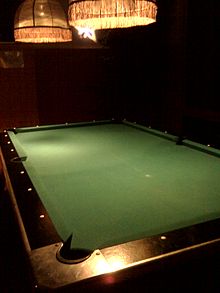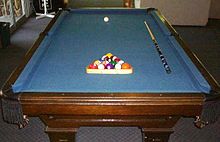Billiard table (pool)
The billiard table for pool billiards differs from other billiard tables primarily in its size and play area design. The sizes and designs are specified in a standard by the official associations (e.g. DBU = Deutsche Billard-Union e.V.).
According to this, two so-called playing field sizes are bindingly permitted (permitted tolerances of ± 0.5%):
- The 8- foot table, playing surface, length to width = 2240 mm × 1120 mm, minimum weight: 300 kg (minimum size for (internal) championships)
- The 9-foot table, playing surface, length to width = 2540 mm × 1270 mm, minimum weight: 350 kg (dimensions for Bundesliga, German and international championships).
- The 6-foot table at Blackball (dimensions for Bundesliga, German and international championships).
This results in a ratio of 2: 1 between length and width. The table height must be between 750 and 850 mm.
Components
The outer frame (perimeter) must be at least 100 mm wide so that the fingers can be used to guide the cue . In the head and Fußbandenspiegeln are each three, and in the longitudinal band mirrors six marks (the so-called diamond) in normalized equal intervals (ratio: 1: 8, the pitch length) available. You are e.g. B. made of ivory , metal, mother-of-pearl or other material either round or angularly incorporated into the band area. There are three of the markings to the right and left of the center pocket ( lower pocket / perforated pocket ) in each of the longitudinal belt mirrors . These markings help to calculate the board game and the allusion to the game balls. The four corner pockets are further sink pockets / perforated pockets , so that the table has six pockets / perforations .
The dimensions of the center pockets are 135 mm to 145 mm at the front and 110 mm to 120 mm at the rear, while those of the corner pockets are 125 mm to 135 mm at the front and 105 mm to 115 mm at the rear.
Depending on the equipment, the perforated game balls can be guided to a collection point via a return system (ball return system), at the side or at the foot end below the playing level , and the white ball (mainly on commercial tables) is ejected for reuse .
The board wood is the wood to which the board rubber is glued to a pool table. It has to have a certain angle on one side so that the foremost corner of the rubber band has a height of about 36 mm. Later both are covered with a billiard cloth.
The band density is decisive for the impact, running and spin behavior of the game balls and is defined in terms of hardness , which results from the rubber mixture .
The playing surface usually consists of two or three sanded slates with a thickness of at least 25 mm (~ 1 inch) for tournament tables, which are joined together when the table is set up. There are also one-piece panels up to 6 cm thick, but they are difficult to transport. The joints are filled with a two-component spatula (e.g. car spatula) to even out the gap between the panels. Then they are ground to a playing surface. On cheap tables you will also find a material plate instead of the slate plate. The billiard cloth (table cover) is clamped to the head side, fixed to the foot side , stretched and fastened to the foot side with clamps. The same thing happens with the two long sides . On tables that do not offer the option of attaching the cloth with clamps, the cloth is attached using spray adhesive. (The time required for removing the old cloth and applying the new cloth is around 2½ hours for a trained person.)
The band reference (Band cloth) is stapled, and the bands (mm 36-37 mm high) may be screwed to the table. Shawls are available in numerous colors and qualities. (The time required to remove the bands, the old cloth and apply the new cloth is about three hours for a trained person.)
Furnishing
Below the table there are devices on the long side that are used to store cues and the bridge.
At the moment are among others the billiard towels 760, 860 from Iwan Simonis from the European Pocket Billiard Federation and the German Billard Union ; and additionally the Z9 billiard cloth and cloths from Milliken have been certified by the DBU .
Space requirement
There should be at least 150 cm of space between the edge of the field and each wall of the room. This additional space requirement is used for getting out with the billiard cue , which is usually about 147 cm long . This is how the space requirement is calculated in order to be able to play without any problems. However, since the white cue ball rarely stays directly on the board, you can play billiards even if there is less space. Should the ball stop right next to the board, the players use a shorter billiard cue for this one move . The space requirement should not be calculated in square meters, as you have to consider the length and width of the room individually.
So it results:
For an 8-foot table you need a room with a minimum size of 5.24 × 4.12 m.
For a 9-foot table you need a room with a minimum size of 5.54 × 4.27 m.
See also
Web links
- epbf.com - Catalog of standards for American pool billiard tables (PDF file, 139 kB) ( Memento from August 17, 2007 in the Internet Archive )
- DBU general guidelines
- DBU material standard pool status 12/2007 (PDF; 157 kB) accessed September 22, 2012

